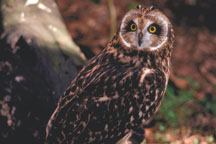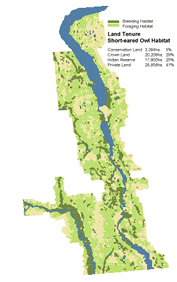|
Habitat Atlas for Wildlife at Risk
Short-eared Owl
Asio flammeus

Short-eared
Owl
|

- Length: 35 - 44 cm; wingspan: 1 metre.
- Short 'ears' are actually tufts of feathers on
top of their heads; real ears are hidden under feathers
on the sides of their heads.
- Tawny plumage with dark streaks on underparts.
- When in flight, black patches can be seen near
bend of underwings.
Status:
British Columbia Blue List
Canada: Vulnerable
Special Significance
In British Columbia Short-eared Owls are found in a
variety of open areas including estuaries, grasslands,
marshes, fields, tundra, alpine meadows and rangelands.
These owls may have an important role in agricultural
areas where rodents can cause crop damage. Short-eared
Owl populations are declining primarily due to the
loss of their breeding habitat due to urban, agricultural
and recreational development. Much of this owl's
habitat is now on privately-owned agricultural land.
Landowners are encouraged to assist the continued
survival of this rare owl. Farmers are encouraged
to leave some of their fields unplanted each year
or to delay harvesting until after the owl's nesting
season.
Distribution
- Breeds throughout British Columbia wherever suitable habitat exists.
- Fraser River delta is the main wintering area in
British Columbia.
- This species has not nested in the South Okanagan
for over a decade and is only occasionally
sighted.
- Nests from sea level to 975 metres.
Habitat
- Breeding habitat is in open country with short vegetation including
rangelands, grasslands, near dry marshes, farmlands,
low arctic tundra, brushy fields and forest clearings.
- Nests are built on the ground in dry marshes or tall
grass meadows.
- Forage over open fields during the early morning
or late evening.
- Short-eared Owls overwinter in old fields, hay meadows,
pastures or marshes.
Reproduction
- Nesting occurs from March to mid-July; nest is a shallow scrape
on the ground in tall grass or marsh vegetation.
- Number of eggs laid depends on abundance of mice; in
British Columbia usually lay 6 or 7 eggs.
- Eggs are incubated by females for 23 to 29 days; young
are ready to fly within four weeks.
Food Habits
- Diet consists almost entirely of voles (meadow mice), but occasionally
eats other rodents, shrews and small birds.
Interesting Facts
- Short-eared Owls are most active at dawn and dusk, instead of
at night like most owls.
- Normally a quiet bird, although when courting and nesting
they make a variety of barking or yapping calls;
also clap wings in flight as part of courtship display.
- Enjoy sunbathing; they face the sun with their eyes
closed and wings spread.
- Sometimes Short-eared Owls roost together in flocks
of 100 birds or more in winter.
- Young owls learn to walk and run before learning to
fly because they nest on ground.
Threats
- Habitat loss due to urban, agricultural and recreational
development.
- Disturbance of nesting sites by humans or livestock.
- Destruction of nests during harvesting of hayfields.
Management Considerations
- Leave some agricultural fields unplanted each
year or delay harvesting until after the
owl's nesting season.
- Protect known nest sites from human disturbance.
- Discourage free-roaming cats and dogs from nesting
areas.
- Protect important habitat such as marshlands,
tall grass meadows and grasslands.
- Maintain good range condition in grasslands to
provide habitat for main prey species.
|
References
1. Campbell, R.W., N. K. Dawe, I. McTaggart-Cowan, J. Cooper, G.
Kaiser and M.C. McNall. 1990. Birds of British Columbia: Volume 2.
Royal British Columbia Museum,Victoria, BC.
2. Clark, R.J. 1975. A field study of the Short-eared
Owl, Asio flammeus (Pontoppidan), in North America. Wildlife Monographs.
47: 1 -67.
|